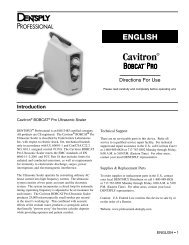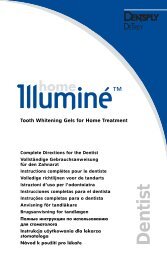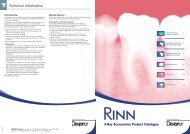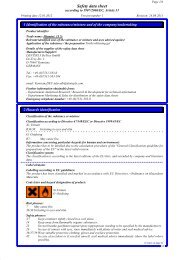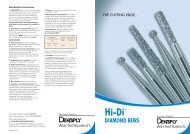Long-term release of monomers from modern dental ... - Dentsply
Long-term release of monomers from modern dental ... - Dentsply
Long-term release of monomers from modern dental ... - Dentsply
Create successful ePaper yourself
Turn your PDF publications into a flip-book with our unique Google optimized e-Paper software.
Monomer <strong>release</strong> <strong>from</strong> composite materials 73<br />
Supreme XT, followed closely by Clearfil Core. Very<br />
small amounts <strong>of</strong> <strong>monomers</strong> were eluted <strong>from</strong> Ceram X.<br />
These findings support the results <strong>of</strong> Franz et al. (26),<br />
who demonstrated that Filtek Supreme XT exhibits<br />
higher cytotoxicity on L-929 fibroblasts than the other<br />
composite materials tested.<br />
According to the manufacturersÕ information, the filler<br />
content <strong>of</strong> these materials is as follows: Ceram X, filler<br />
content 76% by weight; Clearfil Core, filler content 78%<br />
by weight; and Filtek Supreme XT, filler content 78.5%<br />
by weight. These small differences in the filler loading<br />
between the three materials could not be the reason for<br />
our findings. It is more likely that the difference in the<br />
chemistry between the three materials, the filler size, and<br />
the distribution <strong>of</strong> the filler particles could have influenced<br />
our results.<br />
As far as Clearfil Core is concerned, no published data<br />
exist concerning the elution <strong>of</strong> <strong>monomers</strong>. The decreased<br />
degree <strong>of</strong> conversion <strong>of</strong> the chemically cured composites<br />
compared with the light-cured materials (27) could<br />
explain the high degree <strong>of</strong> elution <strong>of</strong> <strong>monomers</strong> <strong>from</strong><br />
Clearfil Core. Storage <strong>of</strong> the samples in ethanol immediately<br />
after their manufacture could have influenced the<br />
<strong>release</strong> <strong>of</strong> TEGDMA and BisGMA because <strong>of</strong> the fact<br />
that the degree <strong>of</strong> conversion Clearfil Core at the end <strong>of</strong><br />
mixing is markedly lower than that <strong>of</strong> photoinitiated<br />
systems. Although such a comparison <strong>of</strong> the composite<br />
materials directly after mixing might be considered to be<br />
quite unfair for the chemically cured composite, as<br />
mentioned above, the use <strong>of</strong> this solution for sample<br />
storage simulates the situation in the mouth. Chemicallycured<br />
materials are generally used as core build-up<br />
materials and therefore they should not come into direct<br />
contact with saliva or oral s<strong>of</strong>t tissues because they are<br />
covered with a crown. However, these materials very<br />
<strong>of</strong>ten remain in the oral cavity for a considerable period<br />
<strong>of</strong> time before they are covered with the final restoration.<br />
Additionally, it is possible that <strong>monomers</strong> can diffuse<br />
through dentin into the pulp (28, 29).<br />
In the present study, the ethanol samples were analysed<br />
using LC–MS/MS. Using this method, substances<br />
with the same mass and retention time can be identified.<br />
The use <strong>of</strong> MS/MS has the benefits <strong>of</strong> separating different<br />
molecular ions, generating fragment ions <strong>from</strong> a<br />
selected ion, and then mass measuring the fragmented<br />
ions. The fragmental ions are used for structural de<strong>term</strong>ination<br />
<strong>of</strong> original molecular ions (23). Therefore, a<br />
combination <strong>of</strong> LC and MS in the form <strong>of</strong> LC–MS/MS<br />
can be very helpful to identify specific compounds with<br />
similar structures, which is one <strong>of</strong> the greatest problems<br />
encountered in analytical methods. In the present study,<br />
the identification <strong>of</strong> specific molecules was studied.<br />
However, it should be mentioned that beside these<br />
molecules, other substances and degradation products<br />
could be <strong>release</strong>d <strong>from</strong> the composite materials. The use<br />
<strong>of</strong> LC–MS/MS could be very helpful in their identification.<br />
An important finding <strong>of</strong> the present study was the<br />
small amount <strong>of</strong> <strong>monomers</strong> <strong>release</strong>d <strong>from</strong> Ceram X.<br />
Ormocer contains inorganic–organic copolymers in<br />
addition to the inorganic silanized filler particles. It is<br />
synthesized through solution and gelation processes (sol–<br />
gel process) <strong>from</strong> multifunctional urethane and thioether(meth)acrylate<br />
alkoxysilanes. By hydrolysis and<br />
polycondensation reactions, the alkoxysil groups <strong>of</strong> the<br />
silane promote the formation <strong>of</strong> an inorganic Si–O–Si<br />
network, while the methacrylate groups are still available<br />
for light-activated organic polymerization. Ormocers are<br />
characterized by the novel inorganic–organic copolymers<br />
in the formulation that allow the modification <strong>of</strong><br />
mechanical properties over a wide range (30). Hickel<br />
et al. (31) suggested that the advantages <strong>of</strong> ormocer<br />
include low shrinkage, high abrasion resistance, biocompatibility,<br />
and caries protection. However, only<br />
limited information is available on the elution <strong>of</strong><br />
<strong>monomers</strong> <strong>from</strong> ormocers and their toxicity. Brackett<br />
et al. (32) found that materials with traditional compositions,<br />
such as Filtek Supreme XT, were severely cytotoxic<br />
throughout an 8-wk interval, but materials with<br />
newer chemistries or filling strategies, such as Ceram X,<br />
improved over time <strong>of</strong> aging in artificial saliva. This<br />
appears to support the claims <strong>of</strong> better polymerization<br />
and lower leaching in newer chemistries (33). The difference<br />
in the chemical structure <strong>of</strong> the composite, and<br />
the variation in the ratio <strong>of</strong> filler and monomer, have a<br />
significant effect on the element <strong>release</strong> and cytotoxicity<br />
level <strong>of</strong> the materials (34).<br />
Regardless <strong>of</strong> the polymerization time, storage time,<br />
and material, a greater amount <strong>of</strong> BisGMA was <strong>release</strong>d<br />
compared with the other <strong>monomers</strong>. As mentioned<br />
above, 75% ethanol has a solubility parameter which<br />
matches that <strong>of</strong> BisGMA and this could be the reason for<br />
the higher amount <strong>of</strong> BisGMA <strong>release</strong>d. Additionally,<br />
BisGMA and TEGDMA differ markedly as far as their<br />
chemical properties and reactive potentials are concerned.<br />
(35). BisGMA is more reactive than TEGDMA,<br />
but the fact that it presents a sterically hindered structure<br />
precludes a higher degree <strong>of</strong> conversion (36). It has been<br />
shown that the quantity <strong>of</strong> unreacted unsaturations in<br />
the BisGMA/TEGDMA system can be qualitatively<br />
correlated with the amount <strong>of</strong> BisGMA in the polymerizing<br />
system (37, 38) and that neat TEGDMA<br />
exhibits a degree <strong>of</strong> conversion that is about 10% higher<br />
than that <strong>of</strong> neat BisGMA (37, 38).<br />
In the present study, BPA was found to be eluted by<br />
unpolymerized composite samples <strong>of</strong> Filtek Supreme XT<br />
and Ceram X and by polymerized samples <strong>of</strong> Ceram X.<br />
This is in contrast to previous studies where no BPA was<br />
detected (15, 16, 25). However, detectable amounts <strong>of</strong><br />
BPA have been mentioned, also by other authors (34,<br />
39), to be extracted <strong>from</strong> composite materials. Dental<br />
composites typically contain <strong>monomers</strong> [such as<br />
BisGMA and bisphenol A dimethacrylate (BisDMA)]<br />
that are derived <strong>from</strong> BPA, but there is no known use for<br />
BPA itself in <strong>dental</strong> composites. As these <strong>monomers</strong> may<br />
leach <strong>from</strong> <strong>dental</strong> composites, their stability has been<br />
studied under a variety <strong>of</strong> conditions to de<strong>term</strong>ine whether<br />
they may hydrolyze to form BPA. BisGMA, the<br />
base monomer for many resin composites, has been<br />
found to be stable under various hydrolytic conditions<br />
(25). However, two researchers have reported that Bis-<br />
DMA is hydrolyzed to BPA, which probably accounts



